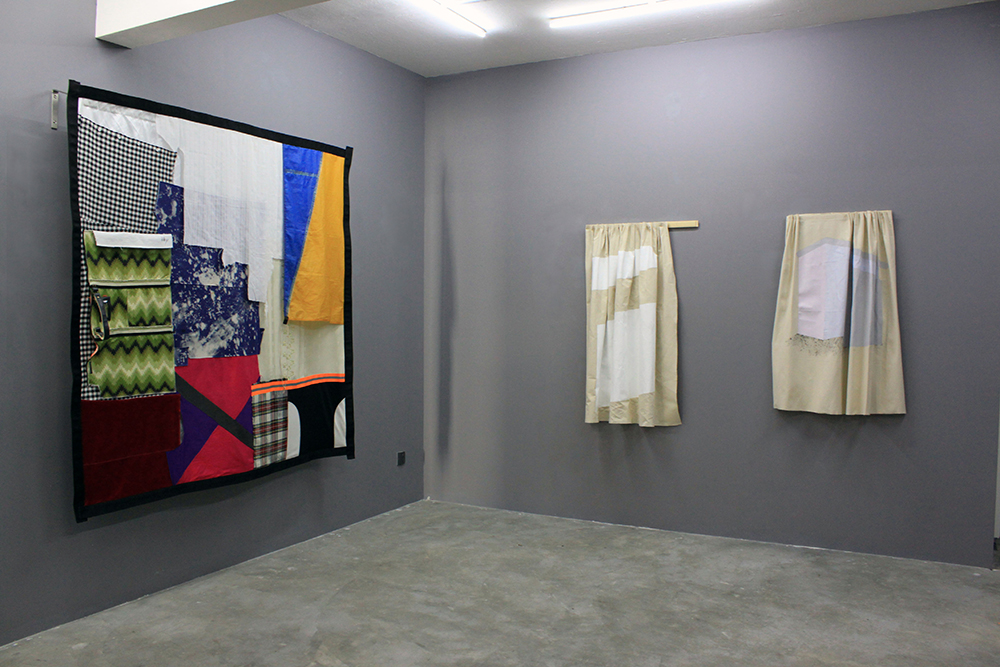The Direction I Rub One Matters [2018]
[19.07.18 — 25.08.18]
Artists: Ian Tee, Moses Tan, Zarina Muhammad, Zulkhairi Zulkiflee
The Direction I Rub One Matters highlights how tactility possesses its own affect; it offers intimacy, comfort, security, and melancholy, among others. The intensities provoked by cloth closely held against skin brings to the fore of our consciousness our desire for and fears of mutuality, shelter, protection, and isolation. The four artists work the suppleness of their various textiles – canvas, polyester, cotton blend, calico, among others – into a critical syntax for describing their specific visualities as well as the textures of these affects. It is the language of the screen, as seen in Ian Tee’s FIRE BLANKET 04, a blanket suspended off the wall becoming a spatial partition that is at once protective and possesses the projective vertical force of a painting or cinema.
It is the vocabulary of the fold; in Zulkhairi Zulkiflee’s Untitled (Type as abstraction) quartet, the photographic images are re-instantiated from their archives while simultaneously obscured from us, the surfacing of a memory compelling to our optics while frustrating us with their ambivalent partialities. The fold in Zulkiflee’s work also suggests a heft the frame and stretch of a painter’s canvas usually belie. In his case, the clue is not a false lead; the small works are surprisingly heavy, the images folded over a space of mostly denser dark wood.
The materiality of our optimistic longing can also be the instantiation of our troubling anxiety. Just as suede changed shade when brushed, the space between the clothed and unclothed, between body and body, can change in perceptible, contrapuntal ways. The fold in Zarina Muhammad’s Sampai Jumpa Lagi (Till We Meet Again) enwraps the space of the rituals of mourning and remembrance, a space that lingers over and infuses our habitation as thoroughly as aromatic esters. The rituals Muhammad summons are those that negotiate our terms for living and dying, for determining the phantom persistence of the human body. Folded one way is the body washed cleaned away, disappearing as dirt do on white cotton. Folded another and the body is alive in all its colours. Moses Tan’s Memorial for Boogie Street is a pair of unconventional shower curtains. Very much not water resistant, these memorials absorb the drips and splashes from the naked body rather than wax and wick them away. The material substrate changes tonality, darkens, what remains steady are his painted marks indicating the queer claims on those spaces for the negotiation of private and public behaviours, the restrooms, bath houses, and public showers that, when glanced one way is innocuous as water, and glanced over once more becomes more troubled, erotic, secretive.
—
Ian Tee’s (b. 1994) practice investigates the social space of abstraction through questioning surfaces and form. Conflating visual language from art history to youth subcultures, he is interested in how aesthetic narratives can be reworked and recontextualised. His work manifests in a variety of media — destroyed metal paintings, bleached and dyed textiles, collage, and modified clothes.
Ian Tee completed his BA Fine Arts at LASALLE College of the Arts, Singapore in 2018. He is a recipient of the Ngee Ann Kongsi scholarship and winner of the 2017 Cliftons Art Prize for Singapore. He is also a contributing writer for Art Republik magazine.
Moses Tan (b. 1986) is an artist based in Singapore. He is interested in research surrounding queer melancholia, resistance through poetic forms and history. Employing drawing, video, sound and materials, he is interested in creating experiences.
He graduated from LASALLE College of the Arts with a BA (Hons) in Fine Arts and a BA (Hons) in Chemistry and Biological Chemistry from Nanyang Technological University.
Zarina Muhammad (b. 1982) is an artist, educator and writer whose practice is deeply entwined with her decade-long multidisciplinary research on the shapeshifting forms and cultural translations pertaining to Southeast Asian ritual magic, sacred sites, forgotten spirits and the tracing of mythological roots of the feared, desired and revered (supernatural) body across the region.
Her series of often collaborative and performance-based works deconstruct and aim to confront histories, texts, definitions, and (mis)representations associated with these bodies of knowledge and polycosmologies. In the various incarnations of her work, she is particularly interested in the broader contexts of myth-making, gender-based archetypes and the region’s tenuous and tentative relationship to mysticism and the immaterial against the dynamics of global modernity.
In 2019, she will begin a research residency at extantation – an experimental performance/art space in Chiang Mai where she intents to look into the ghost/spirit dance traditions in Northern Thailand as part of a broader study on comparative embodied performances in Asia. She has presented her work in Indonesia, Cambodia, Japan, Hong Kong, Malaysia, Singapore, Thailand and Australia.
Zulkhairi Zulkiflee (b. 1991) is a visual artist, educator, and exhibition-maker based in Singapore. His practice explores the notion of Malayness in relation to knowledge production, the social agency and distinction/ taste.
Zulkiflee has exhibited in group exhibitions such as the Young Talent Programme (2017) by the Affordable Art Fair Singapore and ION Art, CICA Contemporary Photography Exhibition Summer 2017 at the CICA Museum, South Korea, as well as Untapped Discovery (presented by Visual Arts Development Association) (2016) at SHOPHOUSE 5, Singapore. His art zine, Pisau & Timun (Knife & Cucumber), has also been acquired by the School of the Art Institute of Chicago (SAIC), catalogued under the Joan Flasch Artists’ Book Collection and shown at The New York Art Book Fair (NYABF) 2016, MoMA PS1, New York. Zulkiflee has organised alternative group exhibitions like LUCKY show (2018), RAID (2018), RUANG (2017) and Dancing on the Spot (2016).






